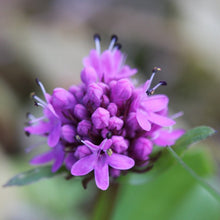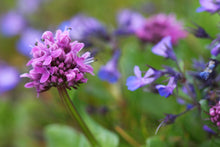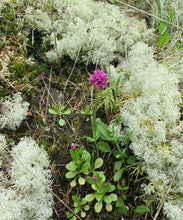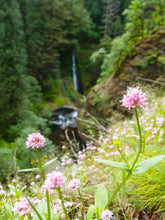
Plectritis congesta
Sea blush is a perky, early-blooming annual wildflower with a relatively compact form. In spring, This plant is covered with terminal clusters of powder-pink flowers in spring and often grows in expansive patches that are highly attractive to overwintering queen bumblebees, clear wing moths and an impressive array of other native pollinators, including the endangered Fender’s blue and Taylor’s checkerspot butterflies.
- Plant type/canopy layer: deciduous, annual (but will self-sow), herbaceous plant
- Size at maturity: 12-24" tall, 4-10" wide
- Light requirements: full sun, part sun/part shade
- Moisture requirements: dry to wet soil
- Bloom time: April - June (April - May in the Portland Metro area)
- Growth rate/ease: medium growth rate, easy to grow
- Wildlife support: flowers attract and provide nectar to adult butterflies, bees and other insect pollinators; overall plant attracts and supports beneficial and other pest eating insects and is a caterpillar host plant and larval food source for native butterflies and moths
- Native habitat/range: grows in coastal bluffs, mountain meadows and partly-shaded spring-wet slopes, sea-level to mid elevations, from California to British Columbia. Portland Plant List - yes.
- Special features & uses: landscape uses include pollinator gardens, rock gardens, and meadowscapes
Gardening with Sea Blush: This plant will do best in dry, rocky areas that mimic the glacial outwash soils it typically calls home. Beyond that, just give it plenty of sun and it’ll be a happy camper. We recommend planting in large swaths, along with other native wildflowers such as common camas, western buttercup, Douglas meadowfoam, globe gilia, and farewell-to-spring to create a vibrant floral show and pollinator paradise from spring through late summer.
Seed Sowing Instructions: Plant between September and November or in March so that seeds will benefit from seasonal rains. If planted later than March, seeds will likely require regular supplemental water during the first summer to complete its lifecycle, thereby developing seeds to drop for next year. Scatter seed on loose-weed free soil and lightly rake in to increase seed-to-soil contact, but be careful not to cover the seed with more than 1/4" soil.
Photo Credit 1 (flower, super close): "Plectritis congesta" by brewbooks is licensed under CC BY-SA 2.0.
Photo Credit 2 (with Collinsia): "Plectritis congesta and Collinsia verna" by brewbooks is licensed under CC BY-SA 2.0.
Photo Credit 3 (on rock wall): "Plectritis congesta (rosy plectritis)" by brewbooks is licensed under CC BY-SA 2.0.
Photo Credits 4 & 5 (in the wild): Nikkie West, Sparrowhawk Native Plants









